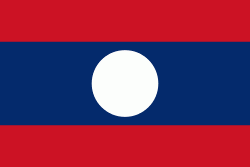Pak Sé District (Muang Pakxé)
Pakse (or Pakxe; French: Paksé; Laotian: ປາກເຊ 'mouth of the river'; ปากเซ) is the capital and most populous city of the southern Laotian province of Champasak, and the second most populous city in Laos. Located at the confluence of the Xe Don and Mekong Rivers, it has a population of about 95,000. Pakse was the capital of the Kingdom of Champasak until it was unified with the rest of Laos in 1946.
The French established an administrative outpost in Pakse in 1905. The city was the capital of the Lao Kingdom of Champasak until 1946 when the Kingdom of Laos was formed. After the Franco-Thai war the French ceded Preah Vihear Province, formerly belonging to the French protectorate of Cambodia, as well as the part of Champasak Province located on the other side of the Mekong river from Pakse, which had been part of Laos, to Thailand.
The city served as the primary seat and residence to Prince Boun Oum Na Champassak, an important figure in the Laotian Civil War. The prince began the construction of Champasak Palace, but fled in 1974 before it could be completed. The town fell to Pathet Lao forces in May 1975. After 1975, Pakse acquired substantial economic importance in the region. The construction of a bridge over the Mekong, built with Japanese aid, allows road traffic with Ubon Ratchathani in Thailand and has further connected the city to neighbouring countries.
The French established an administrative outpost in Pakse in 1905. The city was the capital of the Lao Kingdom of Champasak until 1946 when the Kingdom of Laos was formed. After the Franco-Thai war the French ceded Preah Vihear Province, formerly belonging to the French protectorate of Cambodia, as well as the part of Champasak Province located on the other side of the Mekong river from Pakse, which had been part of Laos, to Thailand.
The city served as the primary seat and residence to Prince Boun Oum Na Champassak, an important figure in the Laotian Civil War. The prince began the construction of Champasak Palace, but fled in 1974 before it could be completed. The town fell to Pathet Lao forces in May 1975. After 1975, Pakse acquired substantial economic importance in the region. The construction of a bridge over the Mekong, built with Japanese aid, allows road traffic with Ubon Ratchathani in Thailand and has further connected the city to neighbouring countries.
Map - Pak Sé District (Muang Pakxé)
Map
Country - Laos
 |
 |
| Flag of Laos | |
Present-day Laos traces its historic and cultural identity to Lan Xang, which existed from the 13th century to the 18th century as one of the largest kingdoms in Southeast Asia. Because of its central geographical location in Southeast Asia, the kingdom became a hub for overland trade and became wealthy economically and culturally. After a period of internal conflict, Lan Xang broke into three separate kingdoms: Luang Phrabang, Vientiane and Champasak. In 1893, the three territories came under a French protectorate and were united to form what is now known as Laos. It briefly gained independence in 1945 after Japanese occupation but was re-colonised by France until it won autonomy in 1949. Laos became independent in 1953, with a constitutional monarchy under Sisavang Vong. A post-independence civil war began, which saw the communist resistance, supported by the Soviet Union, fight against the monarchy that later came under influence of military regimes supported by the United States. After the Vietnam War ended in 1975, the communist Pathet Lao came to power, ending the civil war. Laos was then dependent on military and economic aid from the Soviet Union until its dissolution in 1991.
Currency / Language
| ISO | Currency | Symbol | Significant figures |
|---|---|---|---|
| LAK | Lao kip | â‚ | 2 |
| ISO | Language |
|---|---|
| EN | English language |
| FR | French language |
| LO | Lao language |















